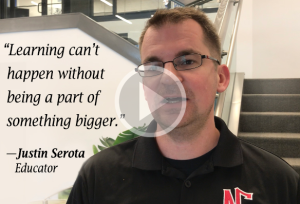Awakening the Potential
 There are no limits, only gaps. The Fort Meade Region is a hotspot for our Nation’s cyber communications, intelligence and global security and, as technology continues to advance at an unprecedented pace, our public-school system is scrambling to bridge the workforce gaps. Resolution begins by offering real-time access to the high-tech world for students peering into their own future. Resolution begins with STEM.
There are no limits, only gaps. The Fort Meade Region is a hotspot for our Nation’s cyber communications, intelligence and global security and, as technology continues to advance at an unprecedented pace, our public-school system is scrambling to bridge the workforce gaps. Resolution begins by offering real-time access to the high-tech world for students peering into their own future. Resolution begins with STEM.
Justin Serota, public school resource teacher for computer science, has always had many interests — sports, history, writing — and he had ample opportunities growing up in the Fort Meade region to develop these interests. What his school was unable to support, however, was his interest in technology. Shortly after the arrival of the internet, Justin figured out on his own how to code websites giving him his first taste of computer science without anyone showing him how this new technology would someday touch everything in the world.
“I didn’t understand what computer science really was,” Justin explains. “I thought of it as just staring at a screen typing in code all day.”
Justin’s misconception made him think computer science wasn’t for him. Because he was eventually able to unlock his passion and make his way back to the classroom as a computer science educator, Justin is able to identify the same misconception in students. In a region where technology is a topic of national security, this kind of misconception is detrimental.
The responsibility to keep our nation safe falls on the shoulders of the Fort Meade workforce. As technology advances and our world changes, there is an historic demand for a qualified and inclusive workforce to maintain the security of our country.
The Fort Meade Alliance recognizes the future sits in the seats of Maryland classrooms. Therefore, integrating STEM-related curriculum and activities into the lives of K-12 students today strengthens the potential of tomorrow’s cyber security workforce. As an educator, Justin believes STEM also gives students the opportunity to take hold of their own future.
“Our job in the education system is to introduce as many options to the students as possible,” Justin explains, “to give them as many opportunities to open up their worldview to find out where they fit best…Digital technology touches so many things today, it really gets kids thinking about all that.”
One of the effective approaches to a STEM program is inviting industry professionals and businesses to be a part of it. At the same time, one of the biggest challenges is mobilizing the placement of qualified experts with the right experience who want to get involved. Most school systems simply don’t have the human resources necessary to regularly mobilize a placement. Justin knows the students are missing out.
“FMA is a big contributor to filling the gap,” Justin says. “FMA provides that link to the outside world where we can help students make those connections through mentorships, internships, developing and implementing curriculum.”
When project-based curriculum is combined with an outside industry-based mentor and integrated into the Maryland school systems, students come out of their shell and feel a sense of real purpose. Conversely, they also gain feedback from a real-world expert who can affirm what they are learning is relevant and will be essential to the future workforce. Some students see themselves in a new way for the very first time.
“We need to connect all students with the community,” Justin insists. “Learning can’t happen without being a part of something bigger.”
Cyber security technology is exponential. In order to keep up with it all, the need to rapidly expand the number of STEM classrooms is now urgent. The STEM programs currently funded by FMA are an integral part of creating these classrooms.
By supporting STEM-related programs, we are spearheading the mobilization of potential in the lives of students who may have misconceptions of the industry like Justin once did, protecting the landscape of our nation’s culture and cyber security and assembling the future workforce.

